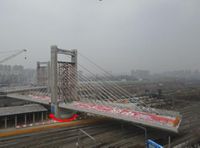In a significant study published on March 23, 2025, researchers investigated the vortex-induced vibration (VIV) performance of a wide Π-shaped main girder bridge located in coastal areas, revealing crucial insights about the effects of ground proximity on bridge safety.
The study highlighted a key finding: as the distance between the girder's bottom and the ground decreases, the amplitude of VIV also decreases. This phenomenon, referred to as the ground effect, is particularly pronounced at lower heights and can nearly suppress VIV entirely.
Wind tunnel tests conducted by the research team from Northeast Forestry University in China demonstrated that varying wind attack angles have a less significant impact on VIV when ground effects are taken into account. "The change in the wind attack angle has a weak effect on the main girder VIV when the ground effect is considered," wrote the authors of the article.
This investigation is vital as vortex-induced vibrations can compromise the structural integrity of bridges, especially those susceptible to strong coastal winds. The typical blunt body configuration of a wide Π-shaped girder can exacerbate these vibrations, raising concerns over the potential for fatigue damage that could lead to safety hazards.
Through sectional model wind tunnel tests, the bridge was subjected to various wind speeds ranging from 2.4 m/s to 9.4 m/s, while the effects of the girder-bottom-to-ground distance were systematically evaluated. The study noted that with the height set to H (10 m), varying distances of 1H, 0.75H, and 0.5H displayed significant differences in VIV performance.
At a height of 1H, the maximum dimensionless vertical bending displacement in the first locking interval was recorded at only 0.0054, a reduction of 23.94% compared to the findings with no ground effect, while the second interval showed a difference of 18.97%.
When the distance fell to 0.75H, the maximum dimensionless displacement for the second locking interval was reduced by an impressive 78.91%, underscoring the effectiveness of the ground's influence. The experiments confirmed that the closer the distance between the girder bottom and the ground, the more pronounced the suppression of VIV, leading to safer structural performance.
In examining the flow dynamics around the bridge, the study utilized Higher-order Dynamic Mode Decomposition (HODMD) to analyze the pressure and velocity fields in relation to VIV. The findings indicated that the first mode (M1) predominantly influenced the ground effect, revealing that the energy of each mode decreased further when the bridge was permitted to vibrate freely.
"Overall, the study provides comprehensive insights into the complex interplay of wind and ground effects on the VIV performance of wide Π-shaped main girders," wrote the authors of the article. This means that the VIV response of bridges may vary based not just on their structural design but also on their interaction with the ground beneath them, suggesting new paradigms for bridge engineering.
The implications of this study reach beyond mere academic interest; they hold practical importance for civil engineering and infrastructure design, particularly in coastal environments where wind effects are a significant concern. Ongoing research in this field could lead to enhanced safety protocols and innovative designs that combine aesthetic considerations with structural integrity.
As engineers and researchers continue to explore the effects of wind on bridge dynamics, understanding the role of ground proximity might provide a crucial tool in mitigating the risks associated with VIV and enhancing overall bridge safety.




